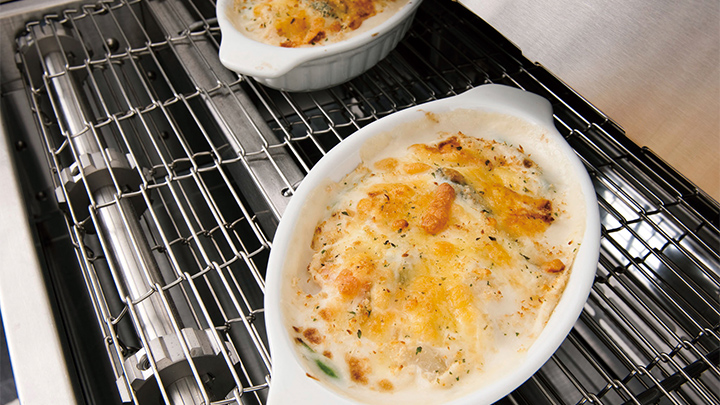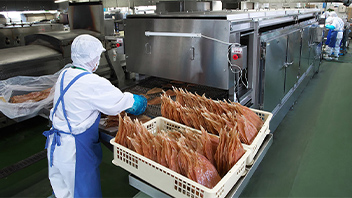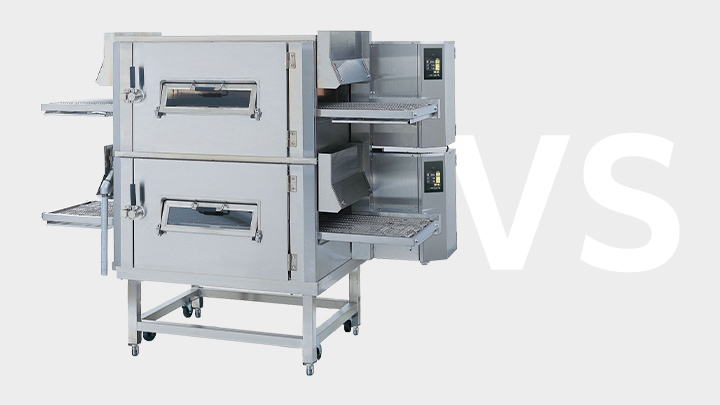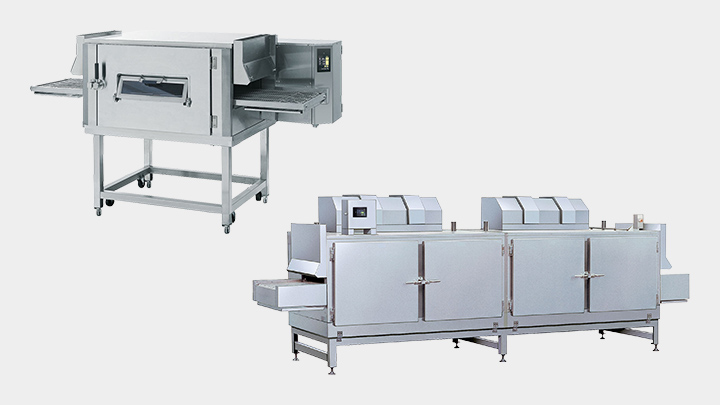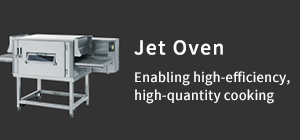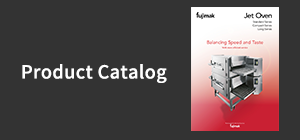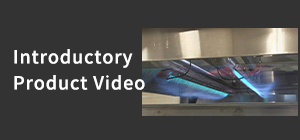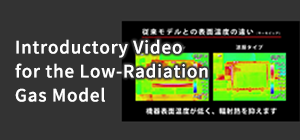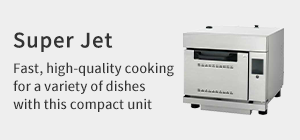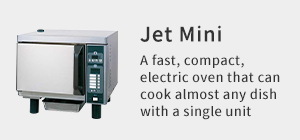Comparisons
We compared the Jet Oven with other ovens and this is how it fared!
![[Comparisons] We compared the Jet Oven with other ovens and this is how it fared!](img/04/mv2.jpg)
We explain the merits of the Jet Oven while comparing it with the infrared conveyor oven--which is mainly used in food factories--the gas convection oven, and the continuous fryer. We hope this will enable you to see the superior processing capabilities, economy, and high cooking quality of the Jet Oven.
Jet Oven vs. Infrared Conveyor Oven
① Quick cooking
with the Jet Oven
With the infrared conveyor oven, the creation of a boundary layer (a layer of cooler air) around the foods being cooked slows the transmission of heat to those foods. Because the Jet Oven blows away that boundary layer and heats the surface of the foods directly, cooking speeds are two to four times faster than with the infrared conveyor oven.
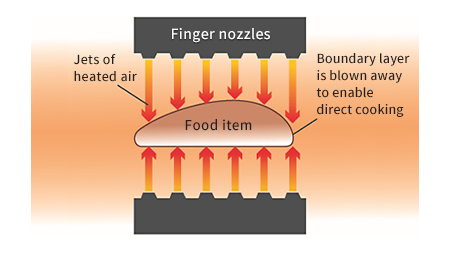
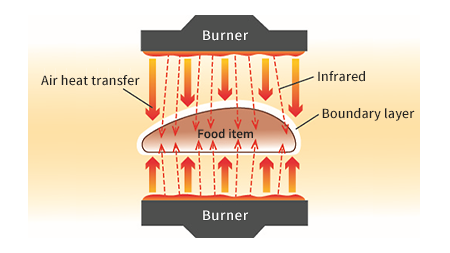
② Stable cooking finish
with the Jet Oven
Because an infrared conveyor oven is affected by the external temperature, the cooking finish varies from day to day and it is necessary to make adjustments for each individual burner. Furthermore, partial clogging of the burners can give rise to uneven heating. In the Jet Oven, heated air is applied to foods uniformly from above and below as they move along the conveyor, thereby providing an even cooking finish. Increases in core temperature are also uniform, which improves food safety. There are reductions in loss from disposal due to fewer mistakes in cooking, and product yields also improve. The internal temperature can be set with one touch using the control panel.
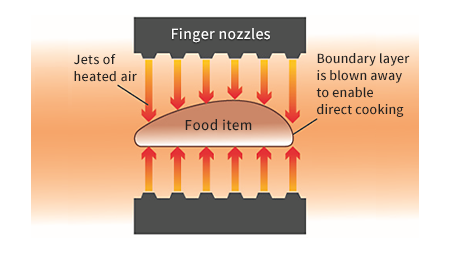
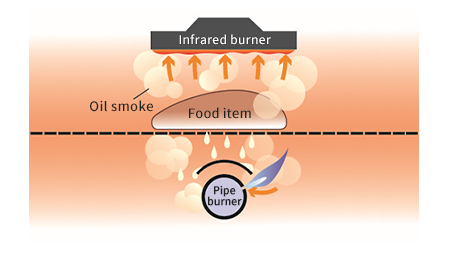
③ Increased processing quantities and reduced running costs
with the Jet Oven
With an infrared conveyor oven, it is necessary for multiple burners to be in operation at all times, which leads to higher running costs. Because the burners cannot be cleaned, they become clogged and damaged due to oil smoke, and it is necessary to replace them on a regular basis.
The Jet Oven is energy efficient because it circulates and reuses heated air. At a seafood processing plant where the Jet Oven is used for baking soft scallops, cooking times are five times quicker compared to infrared conveyor ovens, and gas costs and consumption are one third of what they were before. Furthermore, because the Jet Oven can be disassembled for cleaning and cleaned using water※, burners do not need to be replaced on a regular basis.
* The Compact Series cannot be cleaned with water.

| Jet Oven (FGJOA30) |
Infrared conveyor oven | |
|---|---|---|
| Heating time | 4 min. 20 sec. | 25 min. |
| Hours of operation per day | 2 hrs | 6 hrs |
| Gas consumption per day | 8.34 kg | 25.2 kg |
| Cost of gas per month | 20,016 JPY | 60,480 JPY |
| Cost of gas per year | 220,000 JPY | 731,000 JPY |
* Gas costs calculated based on a price of 120 JPY/kg
Jet Oven vs. Convection Oven
① High-quantity, fast and efficient cooking
with the Jet Oven
The interior of a batch-type convection oven is hermetically sealed, so opening the door to insert or remove food items causes heat to escape and the internal temperature to drop. Manpower is required every time foods are inserted or removed, and when oven pans are replaced to enable uniform, evenly heated cooking. With continuous cooking in the Jet Oven, cooking times are shorter than with a batch-style oven and uniform heating is possible without the use of additional labor.
| Jet Oven (FGJOA30) |
Gas convection oven (FGCO2308 x 3) | |
|---|---|---|
| Cooking time | 7 min. | 12 min. |
| Cooking capacity | 1,503 patties per hour | 360 patties at a time (120 per unit) |
| Notes | Cooking 40 patties per oven pan | 30 sec. to insert food items 30 sec. to remove food items 1 min. to replace oven pans |

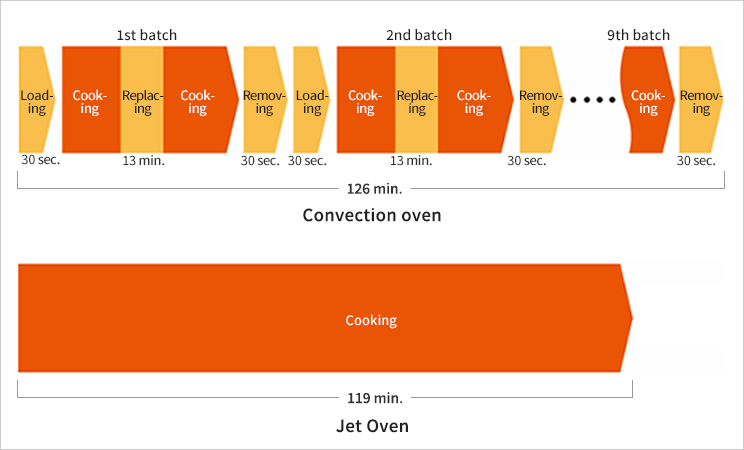
② With the Jet Oven
running costs are also cut
By utilizing the Jet Oven, which enables continuous heating and high-quantity cooking, there are reductions in the amount of gas consumed and in energy costs.
| Jet Oven (FGJOA30) |
Gas convection oven (FGCO2308 x 3) | |
|---|---|---|
| Gas consumption | 58.2 kW | 87.3 kW |
| Gas consumption per day when cooking 3,000 patties |
115.1 kWh | 183.3 kWh |
| Gas costs per day | 1,385 JPY | 2,200 JPY |
| Gas costs per year (365 days) |
505,452 JPY | 803,000 JPY |
* Times vary depending on operating efficiency and the required cooking finish.
③ Greater uniformity and better quality cooking
with the Jet Oven
Because heated air in a convection oven circulates in a fixed direction, a boundary layer (layer of cooler air) remains on the surface of the foods being cooked. Another particularity of convection ovens is that it is difficult to obtain a crispy texture because of moisture remaining inside the oven. In the Jet Oven, jet propelled heat is directly transmitted to foods, and the uniform application of heated air to foods as they move along the conveyor provides an even cooking finish. Moisture is also blown away to give a crispy surface to food items.
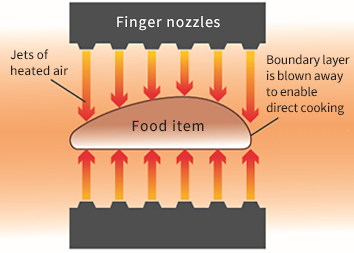
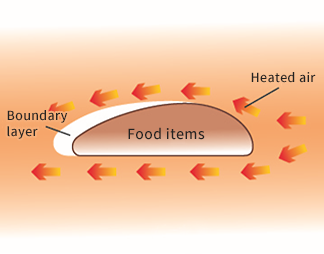
Jet Oven vs. Continuous Fryer
① Cut running costs
with non-fry cooking in the Jet Oven
When cooking deep-fried foods at a food factory in a conventional continuous fryer, while throughput is high, filling the oil tank with a large quantity of oil is expensive. In contrast with this, when using the Jet Oven for non-fry cooking, rather than foods being immersed in oil for frying, they are simply coated in oil, which greatly reduces the amount being used.
| Jet Oven | Continuous fryer (FECF2082L/100 L model) |
|
|---|---|---|
| Cost of purchasing oil (per day) |
194 JPY | 19,250 JPY |
| Cost of disposing of oil (per day) |
0 JPY | 1,100 JPY |
| Total costs per day | 194 JPY | 20,350 JPY |
| Costs per year | 70,810 JPY | 7,427,750 JPY |
* Using and replacing 100 L of oil every day
* Using 1 L of oil per day (2 g of oil applied per food item/5,000 items per day)
Calculated based on 3,500 JPY per 18 L drum and 200 JPY disposal cost per drum (Fujimak calculations)
② You can also save time on oil disposal
with non-fry cooking in the Jet Oven
Daily replacement of the oil in a continuous fryer involves such things as inserting, removing, and filtering the oil, as well as cleaning, all of which require time and labor. With the oil tank and other parts on a larger fryer, it is not unusual for the cleaning alone to take an hour. With non-fry cooking using the Jet Oven, there is no need to take time inserting oil and removing it from the oil tank, and cleaning, too, is simple. This in turn leads to a reduction in working hours.
| Jet Oven | Continuous fryer | |
|---|---|---|
| Time for inserting oil | 0 min. | Approx. 5 min. |
| Time for removing / filtering oil |
0 min. | Approx. 5 min. |
| Cleaning time | 20 min. (disassembly of parts and cleaning of the interior with water are simple) |
Approx. 60 min. |
* Calculations based on production at fujimak
③ Deep-fried foods with added value
thanks to non-fry cooking in the Jet Oven
Non-fry cooking enables the enjoyment of foods with a delicious deep-fried flavor that are also low in calories. The Jet Oven skillfully undertakes non-fry cooking by propelling strong heated air from above and below onto foods that are coated in oil. Because the Jet Oven heats foodstuffs while blowing away moisture, it is possible to achieve the same crispy texture that is found in foods fresh from a deep-fat fryer. It enables the cooking of large amounts of deep-fried foods with high added value that also match the demand for health-oriented menus.
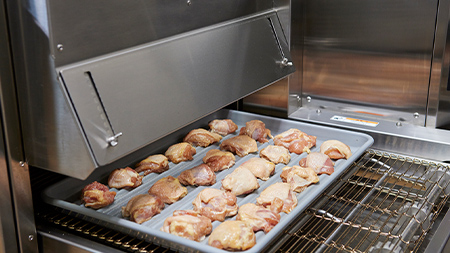

A More In-Depth Introduction
to the Attractions of the Jet Oven
Inquiries relating to this product
For queries and consultations relating to the Jet Oven,
please use the online form.


